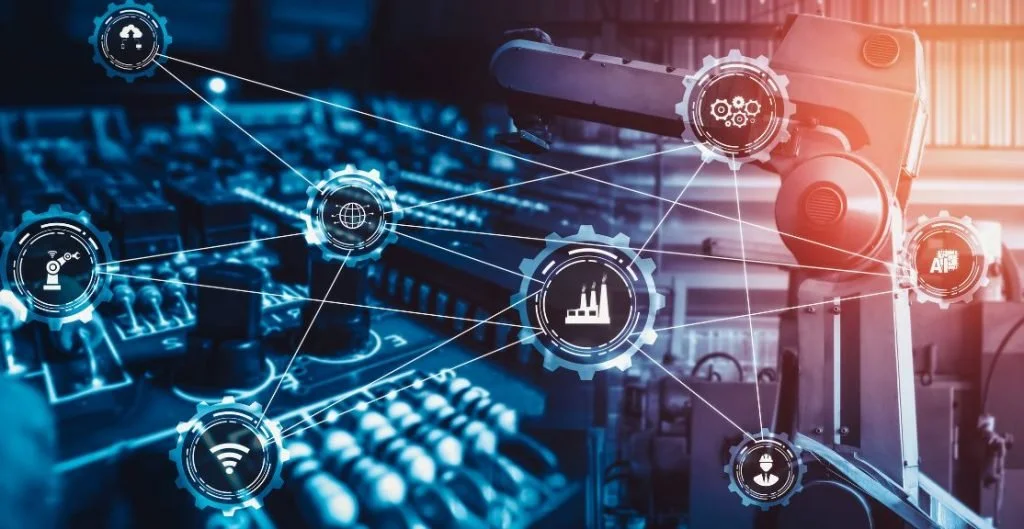Industry 4.0: The Ongoing Revolution and Its Future-Forward Evolution
The German government launched Industry 4.0 as a buzzword in 2011 but it has evolved into the standard framework for contemporary manufacturing operations. The Fourth Industrial Revolution known as Industry 4.0 enables factories to evolve from automated isolated facilities into complete intelligent production systems which operate through seamless machine and system and product communication. Industry 4.0 unites physical and digital domains through multiple revolutionary technologies to establish smart factories which operate through automated machine and system and product communication.
The complete potential of Industry 4.0 together with its future development path has started to emerge because of artificial intelligence progress and edge computing advancements and improved connectivity solutions. The article investigates Industry 4.0 core elements while tracking its current development path which advances past basic connectivity to establish an industrial system that supports industrial sustainability and human involvement.
The Fourth Industrial Revolution depends on four essential technological foundations.
The Industrial Internet of Things (IIoT) serves as the central control system for smart factories. The IIoT system uses sensors to monitor machine and tool and product performance through real-time data collection of performance metrics and temperature readings and vibration patterns and product locations. The continuous data collection process generates the fundamental information which enables all subsequent intelligent operations.
Big Data and Analytics serve as the operational foundation for Industry 4.0. The IIoT generates extensive data streams which get processed through analytical methods to detect patterns and generate forecasts and optimize operational procedures. The system enables organizations to shift their decision-making from basic reaction to advanced predictive and proactive operations.
The operational control of Industry 4.0 depends on Artificial Intelligence (AI) and Machine Learning (ML) systems. The system uses AI/ML algorithms to execute its operations. The system uses learned data patterns to execute predictive maintenance and quality control and production scheduling operations.
The cloud system offers flexible computing resources and data storage capabilities for handling large datasets. Edge computing has become essential for time-sensitive operations because it enables fast data processing at factory floor locations. Edge systems operate at factory floors to process data locally which results in fast response times that enable robotic arm stops before accidents happen.
The manufacturing process benefits from Additive Manufacturing (3D Printing) because it enables production of customized items on demand while minimizing waste and supply chain requirements. The technology produces complex lightweight parts and enables fast prototyping operations.
The new generation of robots includes collaborative robots which operate safely with human workers to execute repetitive work and demanding tasks and precise operations that enhance human performance.
Digital twins represent virtual replicas of physical assets and systems and processes which operate as dynamic models. Engineers use digital twins to test and optimize operations through simulation which enables them to avoid disrupting physical production lines and minimize downtime and development expenses.
The increasing factory connectivity requires organizations to establish robust end-to-end cybersecurity systems which function as essential protective measures for vital industrial systems.
The current industrial landscape shows 4.0 involved testing new concepts through small-scale projects. The current industrial phase focuses on large Industry 4.0 evolving through multiple key developments which drive its advancement.
The first stage of Industry-scale deployment of Industry 4.0 systems while multiple essential developments influence its advancement.
- The AI-First Factory has emerged as a dominant manufacturing approach.
The first AI applications in manufacturing focused on separate operations. The current manufacturing trend involves placing AI systems at the core of all operational processes. The system performs both failure prediction and maintenance solution generation to prevent equipment breakdowns. AI systems now direct complete production operations through their scheduling capabilities. AI scheduling systems operate in real-time to modify production schedules based on material supply and machine performance and customer requirement changes which results in an automatically optimizing factory environment.2. Hyperautomation and the Autonomous Factory:
Hyperautomation enables organizations to automate complex processes through the combination of RPA and AI and ML and IoT technologies which were previously thought to need human intervention. The development of “lights-out” manufacturing facilities now enables specific industries to operate their production lines independently for extended periods. The goal of this technology is to enhance human work by making them responsible for supervising operations and developing strategies and handling exceptional cases.
- Sustainability as a Core Driver (Green Manufacturing):
The circular economy and net-zero targets receive support from Industry 4.0 technologies. AI systems optimize factory energy usage by automatically shutting down equipment when it remains idle. Digital twins enable businesses to select sustainable production methodsT sensor-based carbon footprint tracking and additive manufacturing reduces material waste. The “Green IT” sector has through environmental impact modeling which helps them make better decisions. The production process becomes more efficient through IIo evolved from being a social responsibility program into a fundamental business operations because of both regulatory requirements and market-based consumer preferences.
- Digital Twins Enable Supply Chain Resilience through Their Implementation.
The current worldwide supply chain breakdowns have exposed the weak points that exist in traditional linear supply chain systems. Industry 4.0 provides a solution through digital supply chain twins. Organizations can build complete digital replicas of their risk-free tests of different scenarios including port blockages and geopolitical incidents and supplier bankruptcies. The new supply networks which span from initial material suppliers to final customer delivery points. The system enables organizations to conduct supply chain management approach enables organizations to move from defensive operations to proactive strategic planning.
- The Human-Machine Partnership Evolves: Augmented Reality and Upskilling
The current understanding of Industry 4.0 work roles has evolved from job elimination fears to human involvement in new ways. Frontline workers now possess enhanced capabilities because of Augmented Reality (AR) technology. The combination of AR glasses with repair instructions and remote expert assistance and digital manual access enables technicians to perform their work more effectively. The combination of these features shortens training duration while boosting precision and creating safer working conditions. The shop floor now requires workers to perform knowledge-based tasks instead of manual work so organizations need to spend money on training employees to become data analysts and robot operators and AI system managers.
- Edge AI and 5G: The Latency-Free Backbone
The combination of 5G wireless technology with Edge AI technology enables organizations to achieve new operational capabilities. The combination of 5G’s fast data transfer rates and quick response times enables real-time control of mobile assets including autonomous guided vehicles (AGVs) that operate in factory environments. The combination of Edge AI with these vehicles enables them to perform instant navigation decisions without needing to access cloud-based servers. The system requires zero delay for its operations because it handles applications that need instant responses including precise assembly work and robot swarm coordination.
Challenges on the Horizon
Multiple obstacles continue to obstruct the advancement of Industry 4.0 technology. The lack of standardization between different vendor systems creates a significant obstacle for building a factory with seamless connections. The high expenses and complicated nature of digital transformation make it challenging for small and medium-sized enterprises (SMEs) to implement. Organizations need to maintain ongoing security monitoring because their threat environment keeps changing. Organizations face their biggest obstacle to success because they need to overcome cultural and skill-related barriers which prevent them from adopting data-driven cross-functional operations.
Conclusion: Towards an Adaptive and Responsible Industrial Future
Industry 4.0 has transitioned from being a conceptual idea to becoming an active industrial transformation that advances daily. The technology has progressed from basic automation and connectivity to develop intelligent production systems which operate autonomously and sustainably. The current industrial landscape benefits from advanced manufacturing systems which use AI and edge computing and digital twins to achieve maximum efficiency and resilience and adaptability.The path ahead continues to present numerous challenges. The upcoming development of autonomous systems will reach its peak when self development which uses technology to enhance human creativity while establishing secure ethical frameworks for future industries. The Fourth Industrial-healing systems become capable of repairing themselves without human assistance. Our progress requires us to maintain human-centered Revolution brings humans and machines together to create an intelligent system which responds better and becomes more resistant to challenges.






